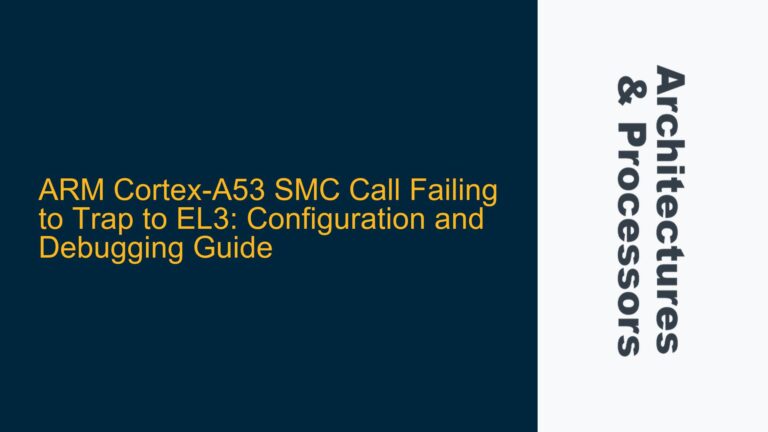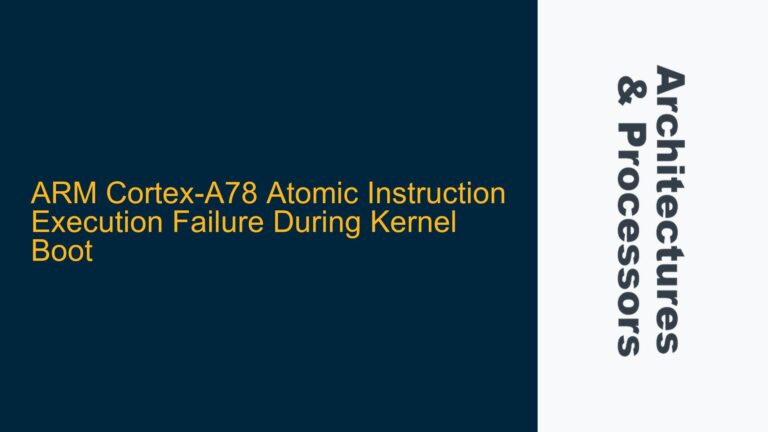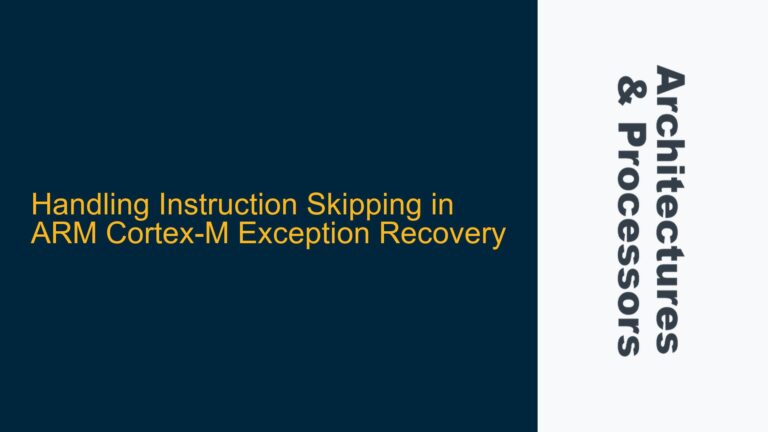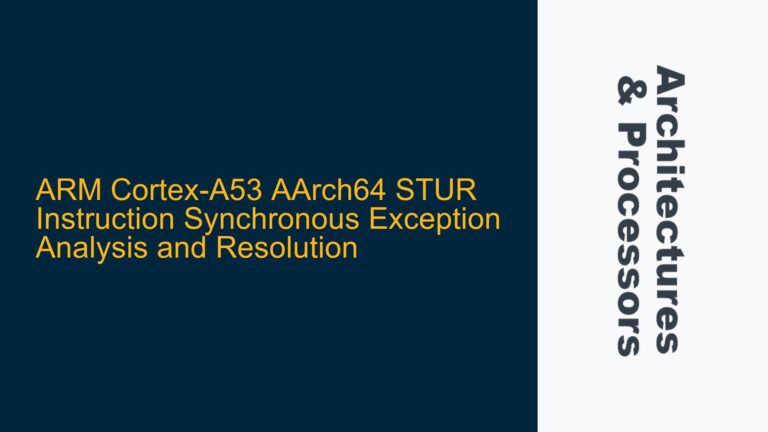ARM VETX.32 Bitwise Rotate Performance Bottleneck on ARM7A
The ARM VETX.32 instruction set includes specialized operations for vectorized bitwise manipulations, which are commonly used in embedded systems for tasks such as cryptography, signal processing, and data compression. One such operation is the in-place bitwise rotate, denoted as VETX.32 q1, q1, q1, #3, which rotates the contents of the quadword register q1 by 3 bits. While this instruction is powerful, users have reported significant performance bottlenecks when executing it on ARM7A processors. The ARM7A architecture, while robust, is not optimized for certain vectorized operations, leading to inefficiencies in execution. This issue is particularly pronounced in scenarios where the bitwise rotate operation is used repeatedly, such as in cryptographic algorithms or real-time data processing pipelines.
The performance bottleneck manifests as increased clock cycles per instruction (CPI), which directly impacts the overall throughput of the system. This is especially problematic in real-time systems where deterministic execution times are critical. The root cause of this inefficiency lies in the microarchitectural implementation of the ARM7A processor, which lacks dedicated hardware for accelerating vectorized bitwise operations. Instead, these operations are emulated using a sequence of simpler instructions, leading to increased latency and reduced performance.
To understand the severity of the issue, consider the following breakdown of the VETX.32 q1, q1, q1, #3 operation on an ARM7A processor. The instruction is decomposed into multiple micro-operations, each of which must be executed sequentially. This decomposition is necessary because the ARM7A does not have a single instruction that can perform a 3-bit rotate on a 128-bit quadword register in one cycle. Instead, the operation is split into smaller chunks, typically 32 bits at a time, and processed iteratively. This iterative approach introduces additional overhead, as the processor must manage intermediate results and ensure data consistency across the iterations.
Furthermore, the ARM7A’s pipeline architecture is not optimized for handling such vectorized operations efficiently. The pipeline stages, including fetch, decode, execute, and writeback, are designed for scalar operations, and the introduction of vectorized instructions disrupts the normal flow of execution. This disruption leads to pipeline stalls and increased CPI, further exacerbating the performance bottleneck.
Microarchitectural Limitations and Instruction Decomposition Overhead
The primary cause of the performance bottleneck in the VETX.32 q1, q1, q1, #3 operation on ARM7A processors is the microarchitectural limitations of the processor itself. The ARM7A architecture, while capable of handling a wide range of instructions, is not designed with vectorized bitwise operations in mind. As a result, these operations must be decomposed into a series of simpler instructions, each of which incurs additional overhead.
One of the key limitations is the lack of dedicated hardware for vectorized bitwise operations. In more advanced architectures, such as ARM Cortex-A series processors, dedicated hardware units are available to accelerate vectorized operations, reducing the number of clock cycles required to execute them. However, the ARM7A does not have such hardware, forcing the processor to rely on software emulation of these operations. This emulation involves breaking down the 128-bit quadword rotate into smaller, more manageable chunks, typically 32 bits at a time. Each chunk is then processed individually, and the results are combined to produce the final output.
The decomposition process introduces several sources of overhead. First, the processor must manage intermediate results, which requires additional registers and memory accesses. Second, the iterative nature of the operation leads to increased latency, as each iteration must wait for the previous one to complete before it can begin. Finally, the pipeline architecture of the ARM7A is not optimized for handling such iterative operations, leading to pipeline stalls and increased CPI.
Another contributing factor is the lack of support for certain advanced instructions in the ARM7A architecture. For example, the ARM7A does not support the VEXT (Vector Extract) instruction, which is commonly used in more advanced architectures to efficiently handle vectorized operations. Without this instruction, the processor must rely on a combination of simpler instructions, such as AND, OR, and SHIFT, to achieve the same result. This not only increases the number of instructions required but also introduces additional latency, as each instruction must be fetched, decoded, and executed individually.
The impact of these limitations is further compounded by the fact that the ARM7A is a relatively old architecture, and its design does not take into account the needs of modern embedded systems. As a result, developers working with ARM7A processors must often resort to workarounds and optimizations to achieve acceptable performance levels.
Optimizing Bitwise Rotate Operations with Alternative Instructions and Techniques
To address the performance bottleneck associated with the VETX.32 q1, q1, q1, #3 operation on ARM7A processors, developers can employ a variety of optimization techniques. These techniques range from using alternative instructions to restructuring the code to minimize the impact of the microarchitectural limitations.
One effective approach is to replace the VETX.32 instruction with a sequence of simpler instructions that achieve the same result but are more efficient on the ARM7A architecture. For example, the bitwise rotate operation can be implemented using a combination of SHIFT and OR instructions. The basic idea is to shift the bits in the quadword register by the desired number of positions and then combine the shifted bits using the OR instruction. This approach avoids the overhead associated with the VETX.32 instruction and can be more efficient on the ARM7A.
Another optimization technique is to use unrolling to reduce the number of iterations required to perform the bitwise rotate operation. Unrolling involves repeating the sequence of instructions multiple times within a loop, thereby reducing the overhead associated with loop control. For example, instead of processing the quadword register in 32-bit chunks, the operation can be unrolled to process 64 bits at a time. This reduces the number of iterations required and can lead to significant performance improvements.
In addition to these instruction-level optimizations, developers can also consider restructuring the code to minimize the impact of pipeline stalls. One common technique is to interleave independent instructions within the loop to keep the pipeline busy. For example, if the bitwise rotate operation is part of a larger loop, other independent operations can be interleaved with the rotate operation to reduce the number of pipeline stalls. This technique, known as instruction-level parallelism, can be particularly effective on architectures like the ARM7A, where pipeline stalls are a significant source of performance degradation.
Finally, developers can consider using specialized libraries or hardware accelerators to offload the bitwise rotate operation from the main processor. For example, some ARM7A-based systems include co-processors or hardware accelerators that can perform vectorized operations more efficiently than the main processor. By offloading the operation to these specialized units, developers can achieve significant performance improvements without having to modify the main code.
In conclusion, while the VETX.32 q1, q1, q1, #3 operation on ARM7A processors suffers from significant performance bottlenecks due to microarchitectural limitations, there are several optimization techniques that can be employed to mitigate these issues. By using alternative instructions, unrolling loops, interleaving independent operations, and leveraging specialized hardware, developers can achieve acceptable performance levels and ensure that their embedded systems meet the required performance criteria.






